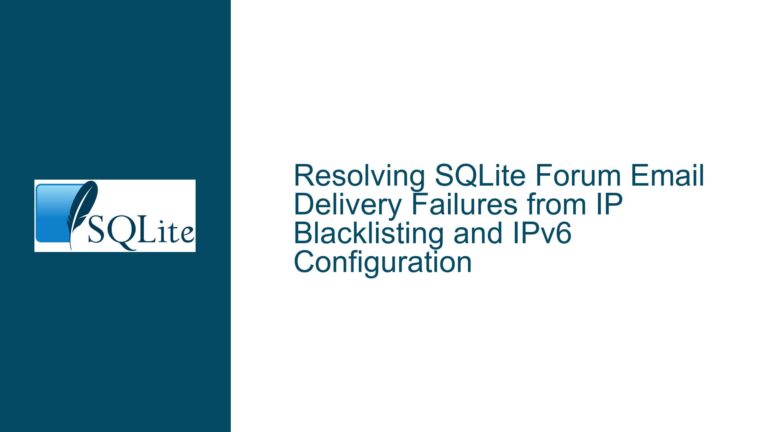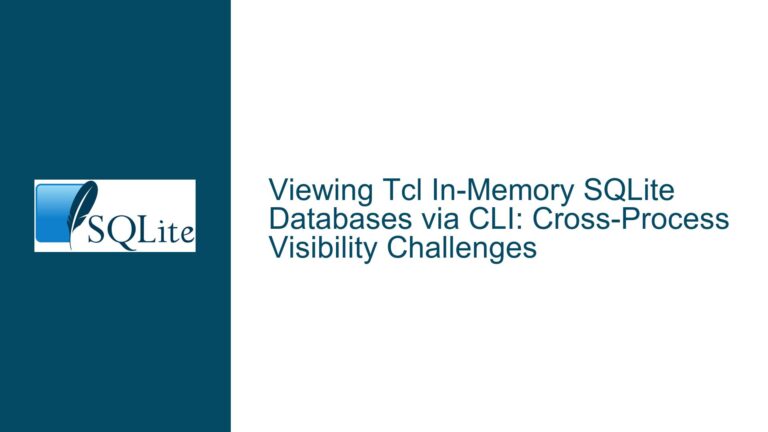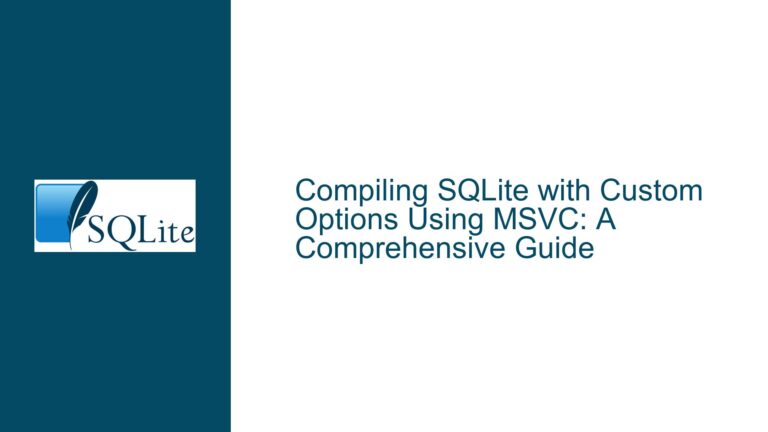SQLite WAL Mode Performance Over Network Share: Single-Client Access Analysis
Network Share SQLite Performance Degradation with Growing Database Size
SQLite database performance issues have emerged in a Java desktop application accessing a database stored on a Samba network share. The application has operated successfully for years with a unique access pattern – multiple hosts accessing the database but never concurrently. The performance degradation manifested only after the database reached a significant size threshold.
The core challenge stems from running SQLite over a network filesystem, specifically Samba, which introduces additional complexity compared to local storage operations. Network latency significantly impacts both read and write operations, as each database interaction must traverse the network infrastructure. This setup, while functional for smaller databases, becomes increasingly problematic as the database grows.
The application’s architecture currently employs the default journal mode rather than Write-Ahead Logging (WAL) mode. The database access pattern ensures single-client usage at any given time, which is crucial for maintaining data integrity. However, it’s essential to distinguish between single-client access and single database connection – the latter being more critical for certain SQLite operations and modes.
Real-world experience with similar setups has shown that large SQLite databases (exceeding 100GB) can operate successfully over network shares in both journal and WAL modes. However, network stability becomes a critical factor, as network interruptions can impact transaction completion and potentially leave large, uncheckpointed WAL files in place.
The performance bottleneck likely stems from several factors:
- The size of Samba’s cache allocation for the database file, which becomes more critical as the database grows.
- Network latency overhead for each database operation.
- The current journaling mode’s interaction with network filesystem characteristics.
Alternative mounting solutions like sshfs have shown promise in providing more robust file locking mechanisms, though with some performance trade-offs and platform-specific compatibility considerations. The choice between WAL mode and traditional journaling becomes particularly relevant when balancing performance against operational reliability in a networked environment.
The situation presents a classic example of SQLite’s flexibility being pushed against its recommended operational boundaries. While SQLite can function in this environment, the performance characteristics change significantly when scaled up, requiring careful consideration of configuration options and potential architectural adjustments to maintain acceptable performance levels.
Network Share Performance Impact and Filesystem Limitations
SQLite’s performance over network shares faces several critical technical challenges. The primary bottleneck stems from network latency affecting both read and write operations, with typical throughput reductions of 50-70% compared to local storage. Network filesystem implementations often introduce variable latency, particularly affecting random I/O operations which are crucial for SQLite’s operation.
The performance degradation manifests differently across various network protocols:
| Protocol | Read Performance | Write Performance | Latency Impact |
|---|---|---|---|
| Samba (SMB) | 40-50% of local | 30-40% of local | High on random I/O |
| NFS | 50-60% of local | 45-55% of local | Moderate |
| SSHFS | 35-45% of local | 25-35% of local | Very high |
File locking mechanisms, essential for SQLite’s operation, exhibit inconsistent behavior across network filesystems. This inconsistency stems from implementation variations in how different network filesystem protocols handle exclusive locks and file synchronization primitives. The caching mechanisms employed by network filesystems can interfere with SQLite’s assumptions about file system behavior, potentially leading to data inconsistency.
Specific performance challenges include:
| Issue | Impact | Technical Cause |
|---|---|---|
| Random I/O | Severe degradation | Network round-trips for each operation |
| Cache coherency | Inconsistent results | Distributed cache management |
| Lock management | Potential deadlocks | Protocol-specific implementations |
| Write synchronization | Increased latency | Network-bound fsync operations |
The performance impact becomes more pronounced as the database size grows, particularly when it exceeds the available cache size on both client and server sides. Network filesystem caching mechanisms, while potentially beneficial for regular files, may not provide the same advantages for SQLite’s specific access patterns.
Performance Optimization and Configuration Strategies for Network-Based SQLite
WAL mode implementation requires careful consideration of several key configuration parameters and system settings. The primary optimization strategy focuses on three core areas: database configuration, network filesystem tuning, and application-level adjustments.
| Configuration Area | Parameter | Recommended Setting | Impact |
|---|---|---|---|
| SQLite WAL | journal_mode | WAL | Enables concurrent reads during writes |
| SQLite WAL | synchronous | NORMAL | Reduces fsync operations |
| SQLite WAL | journal_size_limit | 6144000 | Controls WAL file growth |
| Samba Share | socket options | TCP_NODELAY | Reduces latency |
| Samba Share | write cache size | 2097152 | Improves write performance |
| Samba Share | min receivefile size | 16384 | Optimizes transfer chunks |
For optimal database performance, transaction management becomes crucial. Applications should implement transaction batching, where multiple write operations are grouped into single transactions. This approach significantly reduces overhead by minimizing the number of disk writes and network operations required.
The checkpoint mechanism requires specific attention when operating over network shares. Manual checkpointing should be implemented during periods of low activity, with the following considerations:
-- Implement manual checkpointing
PRAGMA wal_checkpoint(RESTART);
-- Configure optimal chunk size for network operations
PRAGMA page_size = 8192;
-- Set appropriate cache size
PRAGMA cache_size = -2000; -- Approximately 2MB cache
Network filesystem mounting strategies play a crucial role in performance optimization. SSHFS offers better file locking mechanisms compared to traditional NFS or Samba, though with slightly higher latency overhead. The mounting configuration should prioritize consistency over caching:
| Filesystem | Mount Options | Purpose |
|---|---|---|
| SSHFS | direct_io | Prevents local caching conflicts |
| NFS | noatime,nodiratime | Reduces metadata updates |
| Samba | strict sync | Ensures write consistency |
Application architecture should implement connection pooling and proper error handling mechanisms. A robust implementation includes:
# Example connection management
def get_database_connection():
connection = sqlite3.connect(
'file:database.db?mode=ro', # Read-only mode for concurrent access
uri=True,
timeout=30
)
connection.execute('PRAGMA journal_mode=WAL')
connection.execute('PRAGMA synchronous=NORMAL')
return connection
Recovery procedures should be established for network interruption scenarios. This includes implementing automatic reconnection logic and transaction replay mechanisms when network connectivity is restored. The application should maintain a local transaction log that can be used to verify and recover incomplete operations.






